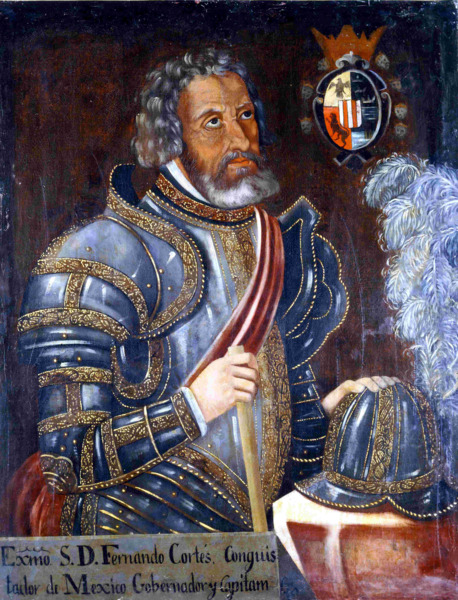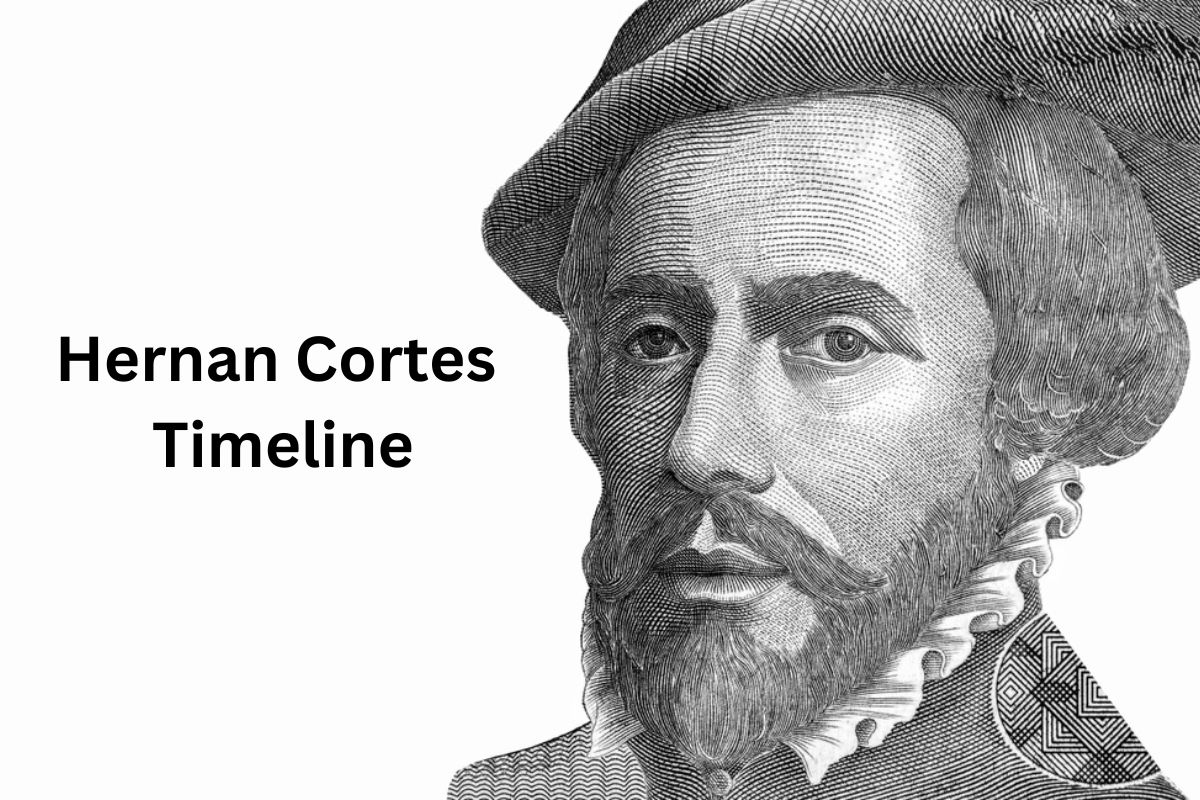Hernán Cortés was a Spanish Conquistador known for leading the expedition that led to the downfall of the Aztec Empire in the 16th century.
Born in Medellín, Spain, in 1485, he left for the New World in 1504, seeking fortunes and embarking on several expeditions in the Caribbean.
His most significant achievement was the conquest of the Aztec Empire in what is now Mexico. In 1519, he landed on the Yucatán Peninsula, formed alliances with some local indigenous groups, and marched to the Aztec capital, Tenochtitlán.
The city fell in 1521, marking the end of the Aztec Empire and the start of Spanish rule in Mexico, with Cortés as the governor of the newly formed New Spain.
Over the following years, Cortés continued exploring other parts of Mexico and Central America. After a series of political disputes and unsuccessful expeditions, he returned to Spain in 1541, where he lived the rest of his life.
Hernán Cortés died in 1547, leaving behind a complex legacy of conquest, colonization, and cultural exchange between the Old and New Worlds.
| Year | Event |
|---|---|
| 1485 | Born in Medellín, Spain. |
| 1504 | Sailed to the island of Hispaniola in the Caribbean Sea at the age of 19. |
| 1506 | Participated in the conquest of Hispaniola and Cuba. |
| 1511 | Participated in the conquest of Cuba under the command of Diego Velázquez de Cuéllar. |
| 1518 | Put in command of an expedition to Mexico by Diego Velázquez, the governor of Cuba. |
| 1519 | Landed on the Yucatán Peninsula in Mexico, founded the city of Veracruz and declared himself the expedition commander. |
| 1519-1521 | Led the expedition that resulted in the fall of the Aztec Empire. |
| 1521 | On August 13, Tenochtitlán fell to Cortés and his allies, and he became the governor and captain-general of New Spain. |
| 1524-1526 | Led an expedition to Honduras to quell a rebellion against his rule. |
| 1528 | Returned to Spain to plead his case to the king, and received with honors. |
| 1530 | Returned to Mexico and spent much of his time exploring the Pacific coast of Mexico. |
| 1536 | Led an expedition that explored the northwestern part of Mexico and discovered the Baja California Peninsula. |
| 1541 | Returned to Spain, where he spent the rest of his life. |
| 1547 | Died in Spain on December 2. |
Timeline of Hernan Cortes
1485 – Born in Medellín, Spain
Hernán Cortés was born in 1485 into a lesser noble family in the small town of Medellín, in the Extremadura region of Spain. The exact date of his birth is not known. His parents were Martín Cortés de Monroy and Catalina Pizarro Altamirano.

1504 – Sailed to the island of Hispaniola in the Caribbean Sea at the age of 19
Seeking adventure and wealth, Cortés left Spain and sailed for the New World in 1504. He settled in Hispaniola, which was a Spanish colony and a major hub for exploration and trade in the Americas.
Here, he registered as a citizen, which allowed him to receive a small amount of land and Indian slaves as part of the encomienda system.
1506 – Participated in the conquest of Hispaniola and Cuba
Over the next few years, Cortés participated in the brutal conquest of Hispaniola and then Cuba, proving himself a competent and brave soldier. This included fighting against indigenous populations and assisting in establishing new Spanish settlements.
1511 – Participated in the conquest of Cuba under the command of Diego Velázquez de Cuéllar
Diego Velázquez, a relative of the governor of Hispaniola, led the conquest of Cuba in 1511 and Cortés participated under his command.
Cortés demonstrated his leadership skills during this campaign and after the successful conquest, Velázquez became the governor of Cuba and Cortés was appointed as a notary of the town of Azua de Compostela, holding a position of some importance.
1518 – Put in command of an expedition to Mexico by Diego Velázquez, the governor of Cuba
Velázquez, recognizing Cortés’ abilities and ambition, put him in charge of an expedition to explore and colonize the Yucatán Peninsula in Mexico.
However, Velázquez later cancelled the expedition, likely due to the growing tension between him and Cortés, but Cortés went ahead with the expedition anyway.
This disobedience marked the beginning of Cortés’ break with Velázquez and was a critical moment on his path to the conquest of Mexico.
1519 – Landed on the Yucatán Peninsula in Mexico, founded the city of Veracruz and declared himself the expedition commander
Cortés landed in Mexico in 1519 with about 600 men and 11 ships. After skirmishes with the local Mayan population, he founded the city of Veracruz, a strategic move that allowed him to establish a base of operations on the coast. In a dramatic act, he scuttled his own fleet to prevent any ideas of retreat among his men.
Also in 1519, he officially renounced the authority of Governor Velázquez, and declared himself the commander of the expedition under the direct authority of King Charles I of Spain.
1519-1521 – Led the expedition that resulted in the fall of the Aztec Empire
Cortés began his march towards Tenochtitlán, the capital of the Aztec Empire. He made alliances with various indigenous peoples, notably the Tlaxcalans, who were enemies of the Aztecs.
Through a combination of military victories and negotiations, he managed to reach Tenochtitlán, where he was initially welcomed by the Aztec ruler Moctezuma II, who possibly believed Cortés to be a representative of the god Quetzalcoatl.
1521 – On August 13, Tenochtitlán fell to Cortés and his allies, and he became the governor and captain-general of New Spain
After a complex series of events including the death of Moctezuma, a Spanish retreat from Tenochtitlán on the Night of Tears (Noche Triste), and a subsequent siege of the city, Tenochtitlán fell to Cortés and his allies on August 13, 1521.
This marked the end of the Aztec Empire. Cortés was named governor and captain-general of the newly formed colony, New Spain.
1524-1526 – Led an expedition to Honduras to quell a rebellion against his rule
In 1524, Cortés embarked on an expedition to Honduras to quell a rebellion started by one of his former lieutenants, Cristóbal de Olid, who had proclaimed himself governor of Honduras in defiance of Cortés. The expedition was long and brutal, marked by intense hardship and loss of life among Cortés’ men.
1528 – Returned to Spain to plead his case to the king, and received with honors
After several years in Mexico, complaints about Cortés’ leadership led to his return to Spain in 1528 to plead his case before King Charles I.
Although Cortés was received with all the honors due to him as the conqueror of Mexico, he did not regain his position as governor of New Spain. However, he was made the Marquis of the Valley of Oaxaca, a hereditary title for his descendants.
1530 – Returned to Mexico and spent much of his time exploring the Pacific coast of Mexic
Cortés returned to New Spain in 1530 after his time in Spain. By this time, he was no longer the governor, but he remained influential.
He turned his attentions to exploration and spent much of his time exploring the Pacific coast of Mexico, seeking a strait connecting the Atlantic and Pacific Oceans. This was also a time of internal politics and quarrels over land and power.
1536 – Led an expedition that explored the northwestern part of Mexico and discovered the Baja California Peninsula
Cortés led an expedition to the northwestern part of Mexico, exploring the region that is now the Baja California Peninsula. He was seeking a mythical island of gold, often referred to as the “Island of California”, based on popular novels of the time.
The peninsula was initially mistaken for an island. While the expedition did not find the wealth it sought, it contributed to the geographical knowledge of the region.
1541 – Returned to Spain, where he spent the rest of his life
Disappointed by his lack of political power and the failure of his exploration attempts to yield significant wealth, Cortés decided to return to Spain in 1541.
He intended to justify his actions and reclaim his position, but this was largely unsuccessful. He lived the rest of his life in Spain, involved in several lawsuits over debts and claims to his estate.
1547 – Died in Spain on December 2
Hernán Cortés died in Castilleja de la Cuesta, Spain, on December 2, 1547, at the age of 62. He was initially buried in the mausoleum of the Duke of Medina Sidonia in Seville, but his remains were later moved multiple times.
Today, his remains are at the Hospital de Jesús Nazareno in Mexico City, a hospital that Cortés himself founded. Despite his death, the legacy of Cortés lived on, particularly in the cultural and genetic imprint left in Mexico due to the Spanish conquest.
